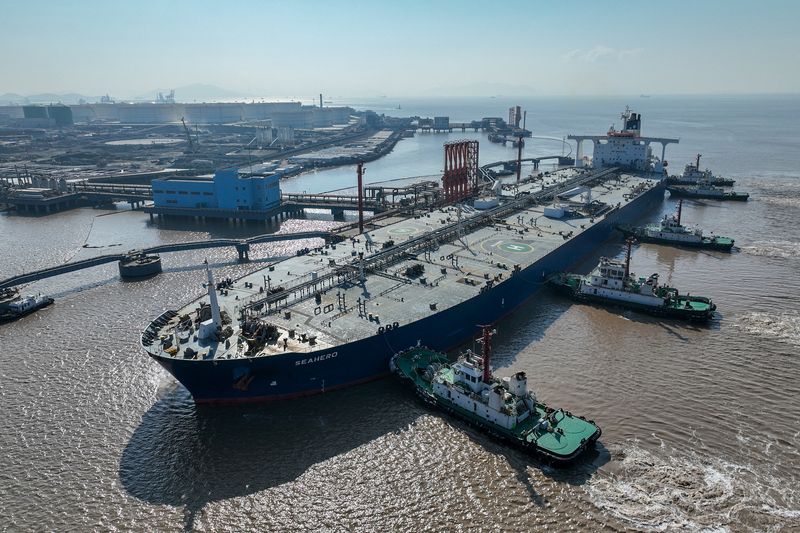Commodities
Oil prices steady ahead of OPEC+ oil production decision


© Reuters. An aerial view shows a crude oil tanker at an oil terminal off Waidiao island in Zhoushan, Zhejiang province, China January 4, 2023. China Daily via REUTERS/File Photo
2/2
By Paul Carsten and Natalie Grover
LONDON (Reuters) -Brent crude futures hovered above $81 a barrel on Friday as traders kept their powder dry ahead of next week’s OPEC+ meeting, which could bring some kind of agreement on output cuts in 2024.
futures were up 22 cents at $81.64 a barrel by 1227 GMT, having settled 0.7% down in the previous session.
U.S. West Texas Intermediate crude were down 45 cents from Wednesday’s close, dropping to $76.40. There was no settlement for WTI on Thursday owing to a U.S. public holiday.
Both contracts were on track for their first weekly gain in five weeks as OPEC+ prepares for a meeting that will have output cuts high on the agenda after recent oil price declines on demand concerns and burgeoning supply, particularly from non-OPEC producers.
The OPEC+ group comprising the Organization of the Petroleum Exporting Countries (OPEC) and allies including Russia surprised the market with an announcement on Wednesday by announcing that its Nov. 26 meeting would be postponed to Nov. 30 after producers struggled to reach a consensus on production levels.
“The most likely outcome now appears to be an extension of existing cuts,” said IG analyst Tony Sycamore.
The surprise delay had initially brought Brent futures down as much as 4% and WTI by as much as 5% in intraday trading on Wednesday. Trading remained subdued during Thursday’s Thanksgiving holiday in the United States.
A bright spot came in the form of the near-term economic outlook in China. Recent Chinese data and fresh aid to the indebted property sector can be “positive for the oil market’s near-term trend”, said CMC Markets (LON:) analyst Tina Teng.
Yet those gains could be capped by higher stockpiles and poor refining margins, leading to weaker demand from U.S. refineries, analysts said.
“Fundamentals developments have been bearish with rising U.S. oil inventories,” ANZ analysts said in a note.
Still, China’s longer-term outlook remains lukewarm. Analysts say oil demand growth could weaken to about 4% in the first half of 2024 as the property sector crunch weighs on diesel use.
Non-OPEC production growth is set to remain strong, with Brazilian state energy company Petrobras planning to invest $102 billion over the next five years to boost output to 3.2 million barrels of oil equivalent per day (boepd) by 2028, up from 2.8 million boepd in 2024.
Commodities
Oil prices rise; U.S. crude inventories plunge, Russia-Ukraine truce eyed
Commodities
India’s Reliance to stop buying Venezuelan oil over US tariffs, sources say
Commodities
Oil prices climb on Venezuela supply worries

 Forex3 years ago
Forex3 years agoForex Today: the dollar is gaining strength amid gloomy sentiment at the start of the Fed’s week

 Forex3 years ago
Forex3 years agoUnbiased review of Pocket Option broker

 Forex3 years ago
Forex3 years agoDollar to pound sterling exchange rate today: Pound plummeted to its lowest since 1985

 Forex3 years ago
Forex3 years agoHow is the Australian dollar doing today?

 Cryptocurrency3 years ago
Cryptocurrency3 years agoWhat happened in the crypto market – current events today

 World3 years ago
World3 years agoWhy are modern video games an art form?

 Commodities3 years ago
Commodities3 years agoCopper continues to fall in price on expectations of lower demand in China

 Economy3 years ago
Economy3 years agoCrude oil tankers double in price due to EU anti-Russian sanctions



























